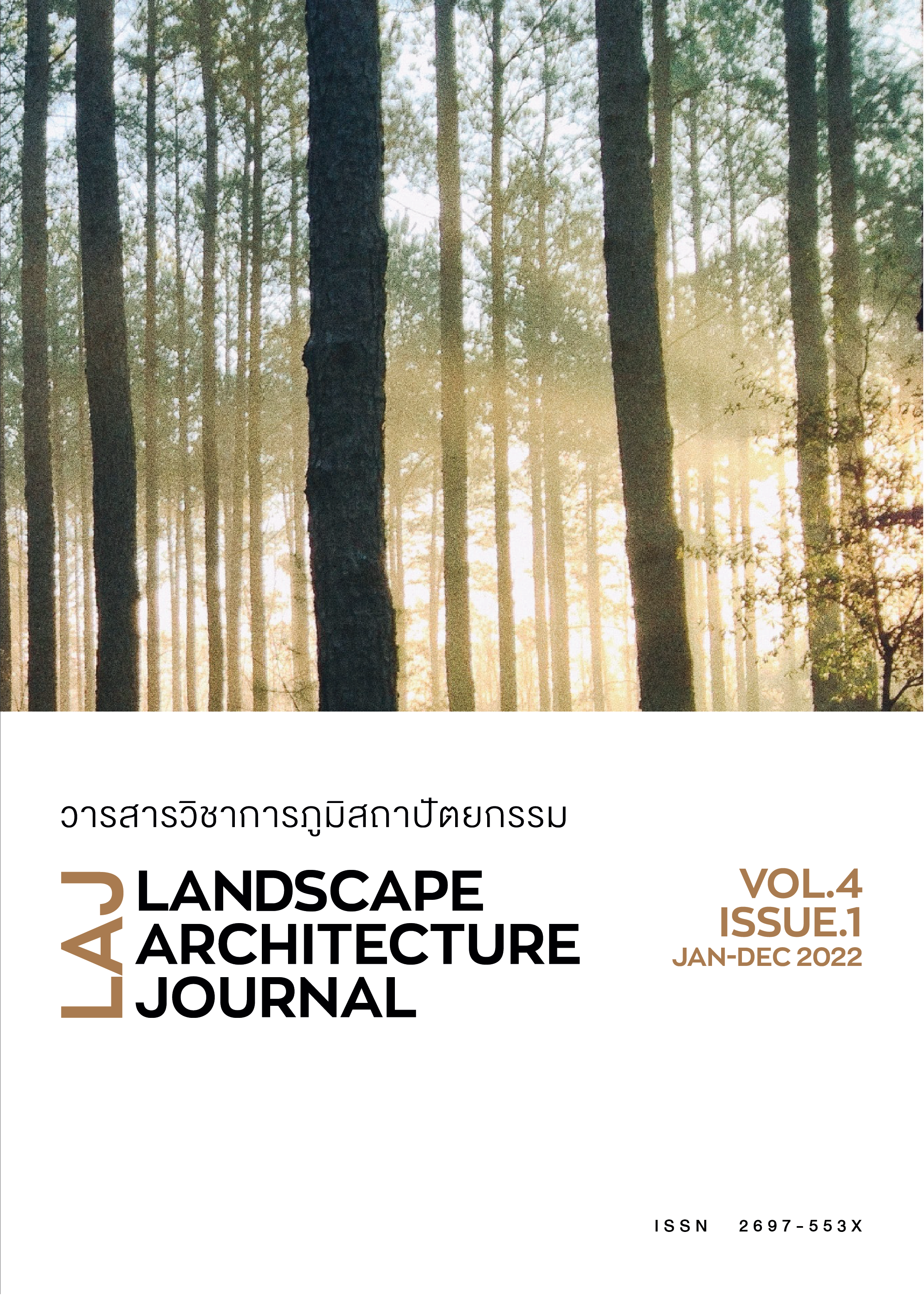The Development of a Tool for Surveying Students’ Attitudes Toward Campus Walkability: A Case Study of Chulalongkorn University
Main Article Content
Abstract
At present, campus walkability is fundamental to the design to enhance the walking experience in the university campuses. In addition, campus walkability affects students’ behavior and perception of the university environment. Past studies have described campus walkability as connectivity, accessibility, safety, comfort, and aesthetics. However, research in Thailand still lacks tools to survey students’ attitudes toward campus walkability. This research aims to develop a tool for Chulalongkorn University. Due to Covid-19, the tool is developed in the form of an online questionnaire in order to collect data from the third, fourth, and fifth-year students in the Faculty of Architecture, Chulalongkorn University, because they have experiences on campus. The questions are developed based on concepts, theories, and studies related to campus walkability as well as students’ walking behavior and perception of the environment. The contexts of the study area are also considered. This questionnaire has been approved by the Research Ethics Committee. It is hoped that the designed tool will be useful for collecting data to conduct the study of campus walkability, and the development of landscape design guidelines for enhancing campus walkability.
Article Details

This work is licensed under a Creative Commons Attribution-NonCommercial-NoDerivatives 4.0 International License.
References
ภาวดี อังศุสิงห์. (2562). “ผังโครงข่ายเส้นทางสัญจรและแผนรหัสในการเก็บข้อมูลภาคสนาม.” ใน กรุงเทพมหานคร: โครงการวางผังโครงข่ายการสัญจรสำหรับผู้มีข้อจำกัดทางการเคลื่อนไหวในเขตการศึกษาจุฬาลงกรณ์มหาวิทยาลัย รายงานขั้นสุดท้าย. กรุงเทพฯ: จุฬาลงกรณ์มหาวิทยาลัย, สำนักบริหารระบบกายภาพ.
ศูนย์การออกแบบและพัฒนาเมือง. (2561). ฐานข้อมูลเมืองเดินได้-เมืองเดินดี (GoodWalk-Database). สืบค้นจาก https://urbandata.theurbanis.com
ศูนย์บริการวิชาการแห่งจุฬาลงกรณ์มหาวิทยาลัย. (2561). “ผลการสำรวจโครงข่ายการสัญจรของจุฬาลงกรณ์มหาวิทยาลัย.” ใน กรุงเทพมหานคร: โครงการศึกษาและพัฒนาโครงข่ายการสัญจรและพื้นที่สาธารณะภายในจุฬาลงกรณ์มหาวิทยาลัยเพื่อการพัฒนาอย่างยั่งยืน รายงานขั้นสมบูรณ์. กรุงเทพฯ: จุฬาลงกรณ์มหาวิทยาลัย, สำนักบริหารระบบกายภาพ.
ศูนย์วิจัยกสิกรไทย. (2563). โครงการกระแสรักสุขภาพจากโควิดธนาคารกสิกรไทย. กระแสรักสุขภาพ.
สํานักบริหารระบบกายภาพ จุฬาลงกรณ์มหาวิทยาลัย. (2563). โครงการปรับปรุงทางสัญจรสำหรับผู้มีข้อจำกัดทางการเคลื่อนไหวบริเวณหน้าคณะวิทยาศาสตร์ ฝั่งสนามหญ้าหน้าพระบรมรูปสองรัชกาล. กรุงเทพฯ : จุฬาลงกรณ์มหาวิทยาลัย.
สํานักบริหารระบบกายภาพ จุฬาลงกรณ์มหาวิทยาลัย. (2563). โครงการปรับปรุงภูมิทัศน์ในมหาวิทยาลัยบริเวณทิศตะวันออกสนามกีฬา. กรุงเทพฯ : จุฬาลงกรณ์มหาวิทยาลัย.
สํานักบริหารระบบกายภาพ จุฬาลงกรณ์มหาวิทยาลัย. (2565). โครงการปรับปรุงทางเดินมีหลังคาภายในมหาวิทยาลัย.
กรุงเทพฯ : จุฬาลงกรณ์มหาวิทยาลัย.
Alfonzo, M. A. (2005). To walk or not to walk? the hierarchy of walking needs. Sage Journal, 37(6), 808-836. DOI: 10.1177/0013916504274016
Dober, R. P. (2000). Campus Landscape: Functions, Forms, Features. NJ: John Wiley & Sons.
Fard, S. J. (2012). “Characteristics of Walkability.” Johor: Walkability in campus, case study of University Technology Malaysia. (Master’ s thesis). University Technology Malaysia, Malaysia.
Ford, A. M. (2013). Walkability of campus communities surrounding Wright State University. (Master's culminating experience). Wright State University, Ohio. Retrieved from https://corescholar.libraries.wright.edu/mph/132/
Garrard, J. (2017). Young People and Walking (A0052693U). Retrieved from https://www.victoriawalks.org.au/ Assets/Files/Final_report_young_people.pdf
Gehl, J. (2010). Cities for People. Denmark: Island Press.
Gehl, J., Gemzøe, L., Kirknæs, S., & Søndergaard, B. S. (2006). New Cities Life. Copenhagen: The Danish Architectural Press.
Harun, N. Z., Nashar A., & Bachok S. (2020). Walkability factors for a campus street. Journal of the Malaysian Institute of Planners, 18(1), 45-55.
Karjalainen, L. E., & Juhola, S. (2019). Framework for assessing public transportation sustainability in planning and policy-making. Sustainability, 11(4), 1-20. Retrieved from https://www.mdpi.com/2071-1050/11/4/1028
Keat, L. K., Yaacob, N. M., & Hushim, N. R. (2016). campus walkability in Malaysian public universities: a case study of universiti Malaya [Special issue]. Journal of Malaysian Institute of Planners, 14(5), 101-114. DOI: 10.21837/pmjournal.v14.i5.196
Makki, S., Surat, M., Che-Ani, A.I., Farkisch, H., & Mokhtarian, H.R. (2012). The importance of design characteristic in walking from student’s perspective: a case study in Universiti Kebangsaan Malaysia. Journal of Building Performance, 3(1), 42-49.
Murwadi, H., & Dewancker, B. (2017). Study of quassessment model for campus pedestrian way, case study: sidewalk of the University of Lampung, Indonesia. Journal of Sustainability, 9(12), 1-16. DOI: 10.3390/su9122285
Southworth, M. (2005). Designing the walkable city. Journal of Urban Planning and Development, 131(4), 246-257.
Sun, G., Acheampong, R. A., Lin, H., & Pun, V. C. (2015). Understanding walking behavior among university students using theory of planned behavior. Environmental Research and Public Health, 12, 13794-13806.
Vongpraseuth, T. & Chitpanya, S. (2018). Toward the walkable campus: Indicators of Design, Density, Diversity, and Climate Conditions at the National University of Laos, Vientiane Capital, Lao PDR. Modern Environmental Science and Engineering, 4(4), 358-364.
Yamane, T. (1973). Statistics: An Introductory Analysis (3rd. ed.). New York: Harper and Row.

